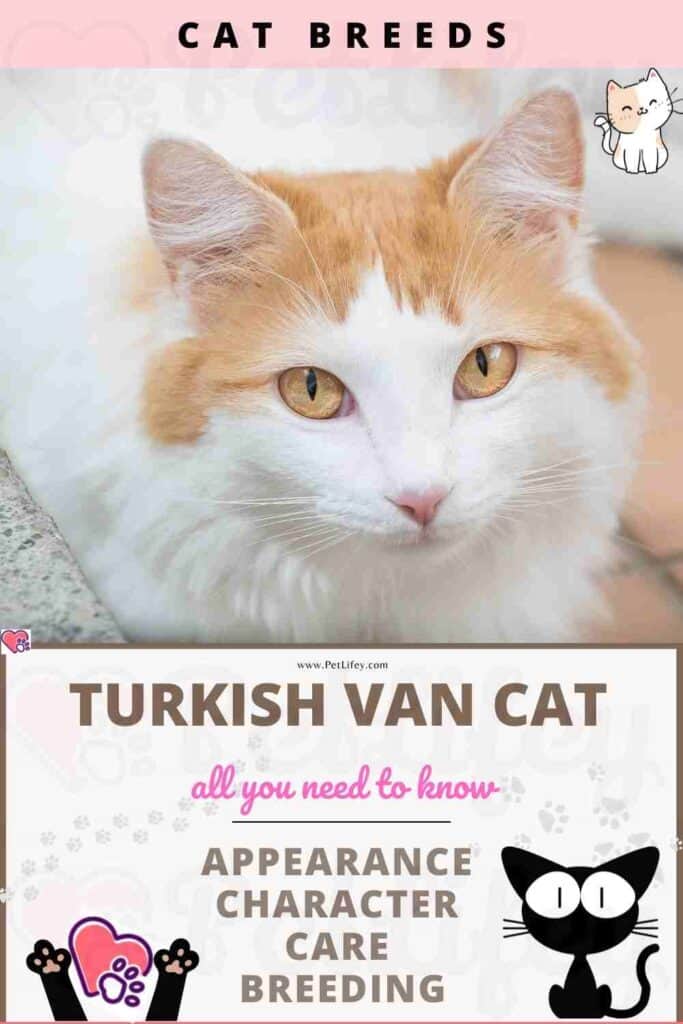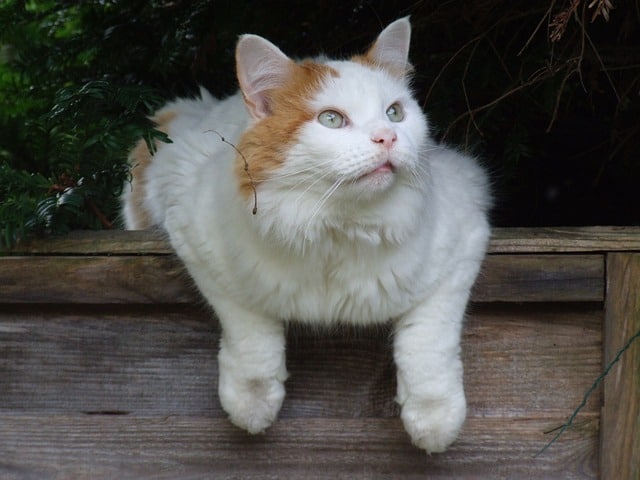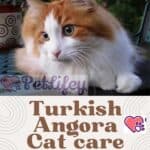
Peremptory and exuberant, the Turkish Van cat (or Turkish Lake Van cat) needs a master willing to live with a boisterous cat and to philosophically take the damage that its impetuosity can cause. It is a very dynamic cat, ill suited to living in a small apartment, even worse if it does not have a balcony.
Its ideal home has a garden, if possible with a few trees it loves to climb on. It is not only not afraid of water, but is even comfortable there: indeed, it is also called the swimming cat.
This characteristic is, it seems, due to the intense heat that reigns in the summer in its region of origin and that this intelligent feline fights while diving in the waters of Lake Van, although a more accredited version explains that it is hunger drives them to the water to go fishing.
The particularly harsh climatic conditions of its native country (the climate can be described as harsh: the winter is freezing, the snow lingers there for long months, and the summer is scorching), as well as the arid and rugged terrain have shaped a truly exceptional cat: robust, heavy and muscular while being agile and slender.
Even her dress is special: in the first heat, she undergoes an impressive moult and the cat completely loses the winter hair provided, to the point that if there was not its tail (which keeps its hair intact) we might mistake them for a short-haired cat.
The origins of the Turkish Van cat

The areas surrounding the slopes of Ararat and Lake Van, which extend south to Iran and Syria, east to Azerbaijan and Bakhtiari and north to Armenia, form a difficult to access ecosystem, ideal for a capillary diffusion of this breed, original and autochthonous.
Its origins are very old; we have thus found certain shields, dating back to the period of the Roman occupation of Armenia (75-387 AD), which represent cats with a clear coat and mid-length hair, provided with ‘a dark tail, in rings.
In 1955, Laura Lushington brought a few specimens back to Great Britain and improved the typical characteristics of this breed, officially recognized between the end of the sixties and the beginning of the seventies.
Appearance of The Turkish Van Cat
The Turkish Van cat is a medium sized cat, its head in the shape of a triangle, is as tall and wide as it is long. Its muzzle is rounded, its chin massive; the cheeks are prominent and the nose is convex.
The ears are large, open at the base and set high on the head; they are slightly oriented either downwards or outwards and of a length equal to the distance between them.
The eyes, expressive and large, are slanted and shaped like a peach stone; they are most often amber in color, but they can also be blue or odd.
The body is tall, long and massive, with a round rib cage; the shoulders are as broad as the head and the ample chest is slender to the abdomen, strong and compact. The musculature is well developed and the bone structure medium.
The legs are of medium length and bone structure, but provided with strong musculature; the hind legs are slightly longer than the anterior ones. The feet are small and round with tufts of interdigital hair.
The tail is of medium length compared to the body, with a brush or plumage hair, deprived of white spots; in tiger varieties, we find the typical darker rings and its color is darker on the upper part than on the lower part.
The coat is medium-long, soft, fine, with a non-woolly, waterproof undercoat that is slightly detached from the body.
As we have already said, it has notable seasonal variations: in summer it is short, except for the tail, panties and belly, where the texture is fluffy; in winter it is fuller, longer and softer.
Coat Color of the Turkish Van Cat
The Turkish Van cat is a two-tone cat whose coat is always very pure plaster white, without any yellowish tinge, while the contrasting color is limited to the tail and head, where the characteristic cap-like design is given by two colored “marks” which end in the area above the eyes and do not extend beyond the ears.
A few small spots on the dress are tolerated, although it would be preferable if there were none. The traditional colors of the “markings” on the head and tail are red or cream, but nowadays Turkish Van are also found with the tails of blue, blue cream and tortie markings.
The character of Turkish Van Cat
The Turkish Van cat is a very lively cat that retains a wild side. It loves to have fun, play and discover always new and stimulating things. It loves its independence but does not shy away from hugs and is affectionate to the point of sometimes becoming a little jealous. It has an exceptional capacity for adaptation but it is rather egocentric.
Hug:
Known to be very affectionate and gentle, this cat will not be asked to receive hugs.
Player:
Very lively and playful, it will appreciate interactive play sessions.
Calm:
It is more in search of fun activities than calm.
Intelligent:
Highly intelligent, the Turk of Lake Van is the ideal candidate for training. Show them how to bring its toy back and thus you’ll kill two birds with one stone: you play with them so you satisfy its need to move and you train them to bring its toy back so you make them work mentally. Something to amuse and exhaust them!
Fearful / suspicious of strangers:
Even if it enjoys company, it is important to respect its tolerance for unfamiliar people and gradually get used to it.
Independent:
It is quite capable of looking after themselves. But beware of the damage it could cause, intentionally or not, if it is lacking in activities!
Behavior of the Turkish Van Cat
Talkative:
The Turk of Van is known to be very talkative, but its voice is not loud or disturbing.
Greedy / gluttonous:
Its appetite is commensurate with its overflowing dynamism. It can be a big eater.
Need for exercise:
This feline needs regular physical exercise to spend its energy accumulated during its periods of rest.
Runaway:
Very lively and curious, it has a strong taste for exploration. Be careful not to leave the window or the door open because he could take the opportunity to sneak in!
Compatibility of Turkish Van Cat with other animals
The Turkish Van and the Dogs:
Playful, curious and dynamic, the Turk of Lake Van is perfectly capable of living in good harmony with a dog if it has been well socialized with the dog being a kitten and that it has places where take refuge in height if necessary.
The Turkish Van and the Other Cats:
Making a good introduction between the Turkish Van and the newcomer will increase the chances of establishing a harmonious cohabitation.
The Turkish Van and the Children:
Dynamic and very playful, it turns out to be a good playmate. It is however important to teach children to respect the limits and moments of calm of their feline friend and to understand its language well. bodily.
The Turkish Van and the Elderly:
Very active and boisterous, the Turk of Lake Van is not the ideal companion for a person looking for a calm and calm cat.
Price of the Turkish Van Cat
On average, the purchase price of a Turkish Van kitten in breeding is between 900 USD and 1300 USD, the price often varying according to the line, the breeding, the age or even the sex. For the monthly budget, it will take an average of 50 USD / month to meet its needs, by offering them a quality diet and making sure to maintain them in good health.
Maintenance of the Turkish Van Cat
Grooming:
During the spring moult, daily brushing will be necessary to get rid of dead hair and prevent it from ingesting too much while grooming.
Hair loss:
In spring, the moult is spectacular. The Van Kedisi loses the majority of its medium-length hairs to be replaced by an almost short coat all over the body in summer.
Food for the Turkish Van Cat
Quality food that meets the needs of an active cat is essential.
Caring of the Turkish Van Cat
The Turkish Van cat does not require any particular care because the absence of undercoat makes the care of its coat very simple; in addition, its great resistance to thermal changes and its robustness make it a strong and very healthy cat.
Health of the Turkish Van Cat
Life expectancy:
The Turkish Van has a life expectancy of between 14 and 19 years.
Resistant / robust:
Its dense fur with mid-long hairs in winter and shorter in summer gives it very good resistance to climates involving extreme temperatures, whether frigid or scorching.
Tendency to gain weight:
This cat does not tend to be overweight given its propensity to remain active, but its appetite should be channeled in the case of a subject with a rather calm lifestyle.
Frequent illnesses:
The Turk of Van is renowned for being a robust and healthy cat so there is no pathology specific to its breed. However, it could develop the same pathologies known to domestic cats, including oral pathologies.
Reproduction:
The only permitted marriages are intra-racial, taking care not to cross two Van Kedisi parents (totally white) in order to avoid the risk of deafness for the offspring.
Good to know
The fur of the Turkish Van is waterproof and this cat is not afraid of bad weather or rain. On the contrary, it is attracted to water and known to be an excellent swimmer.






